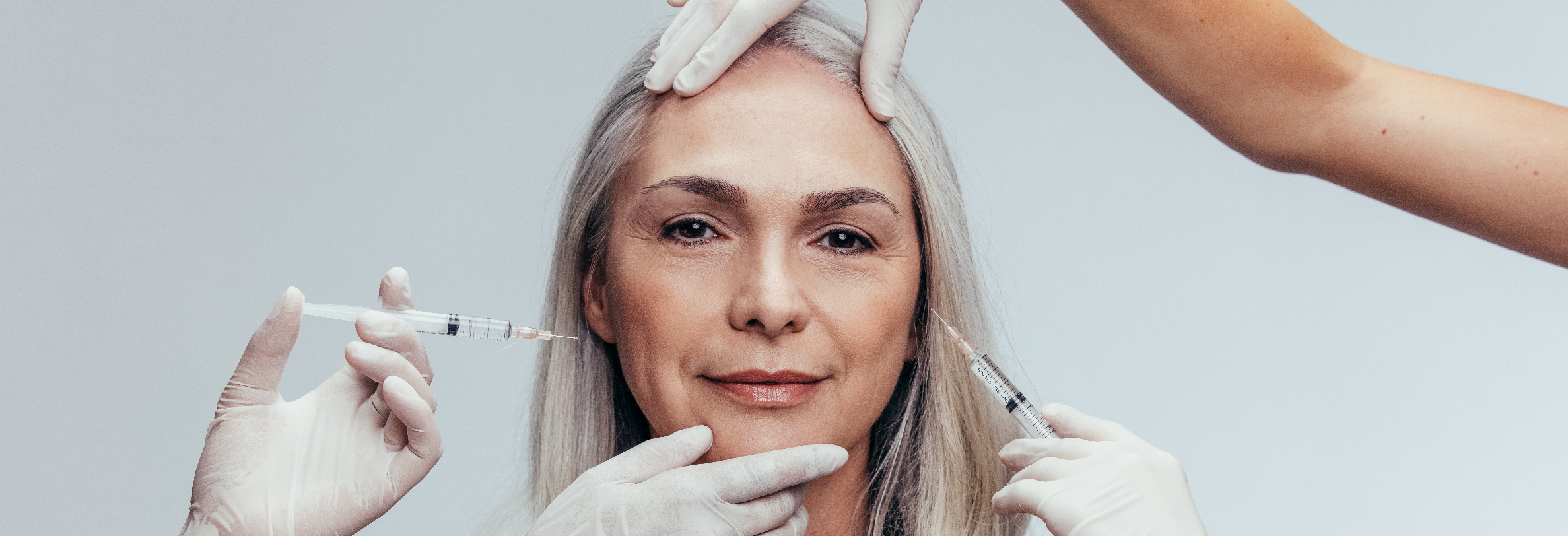Your body is one-of-a-kind, but everyone has a few things in common—like the fact that our bodies change as we age.
At Derma Health, we offer several types of injectable treatments for patients looking to combat signs of aging (fine lines, wrinkles and volume loss), meet their aesthetic goals or both. But what’s the difference between treatments like Botox and dermal fillers?
Let’s break down how each one works, what they’re made from and what they can (and can’t) do for patients looking for anti-aging or other aesthetic solutions. The two products are distinct, so you should ask your provider about which one (or a combination of both) is most compatible with your aesthetic goals, budget, and schedule.
What Are Dermal Fillers?
As we get older, our faces naturally lose subcutaneous fat. Subcutaneous fat is actually one of our skin’s three layers—the top is the epidermis, the middle is the dermis and the bottom is subcutaneous fat.
As this fat layer diminishes with age, the skin becomes thinner, which can emphasize wrinkles (since our muscles are working closer to the top layer of skin). At the same time, the fat pads and muscles on your face begin to slide and shift. This can change the overall structure of your face over time.
Dermal fillers’ primary purpose is to temporarily restore volume, mimicking lost subcutaneous fat. They are also used to add volume to areas that you feel may lack natural contour or balance (such as cheeks, your chin, temples, etc).
However, aging isn’t the only factor that can change the skin on your face and make wrinkles appear more vivid—sun exposure, lifestyle and genetics also impact the thickness of our subcutaneous fat and how quickly it decreases as we age.
What Are Dermal Fillers Made From?
There are four types of dermal fillers approved by the US Food and Drug Administration—three of them are absorbed by the body over time (progressively decreasing their effectiveness), and one is not. Derma Health Skin & Laser offers the Juvederm Collection of Dermal Fillers (Juvederm Ultra, Juvederm Ultra Plus, Voluma, Volbella, and Vollure) and Galderma products (Restylane, Lyft, Refyne, Kysse, Defyne, etc) made from:
- Hyaluronic acid, which is naturally occurring in the body
- Calcium hydroxylapatite, an important compound in bones
- Poly-L-lactic acid (PLLA), a collagen biostimulator
What Can Dermal Fillers Do?
Dermal fillers serve a few different purposes. They can:
- Reduce wrinkles and other facial lines
- Increase the volume of certain facial areas
- Restore or increase fullness in the face
Patients commonly seek treatment with dermal fillers to:
- Enhance their shallow contours
- Decrease the appearance of creases and wrinkles
- Soften facial scars (from injuries, surgeries, or acne)
- Add plumpness to the lips
- Reconstruct facial deformities
- Improve the hollowness in the lower eyelid area (tear troughs)
What Can’t Dermal Fillers Do?
When considering Dermal Fillers, you’ll need to know:
- They’re temporary – Hyaluronic acid dermal fillers used in the face are generally gels—this ensures the product to blend smoothly across your facial features. But, since they’re made up of hyaluronic acid, they absorb into the body relatively quickly—most products last between six months 18 months, depending on your body’s natural metabolism.
- They can’t drastically change your facial structure – Since dermal fillers are a minimally-invasive procedure, they don’t permanently or drastically alter your skin, bone structure or face shape. Sculptra, while considered a Dermal Filler, is different, however. For information about Sculptra, click here. For some patients, surgical solutions performed by a plastic surgeon (like a facelift, eye lift or brow lift) might be more appropriate for severe laxity.
Am I a Good Candidate for Dermal Fillers?
There are two things to consider why you may not be a good candidate for dermal fillers:
- You’re allergic to any of the ingredients used in the product
- You have any health contraindications for treatment
But dermal fillers might be the right choice for you if:
- You have realistic expectations and a positive outlook about the results you want
- You don’t smoke (smokers can still do filler- I would consider removing this)
- You’re in good physical health
- You’re committed to consistently using protective measures, like:
- Regular application of mineral based SPF
- Reduced time in direct sunlight by wearing wide brimmed hats
- Use medical grade skin care
What is Botox?
Botulinum toxin—marketed as Botox, Dysport, Xeomin and Jeuveau—is a prescription based medication used for a variety of both aesthetic and medical purposes for fine lines and wrinkles.
Unlike dermal fillers, Botox doesn’t add or restore volume to the face. Instead, it temporarily blocks the nerve receptors that causes your muscles to stop moving when your face makes an expression.
So, when you receive Botox, your skin holds its resting position instead of forming dynamic wrinkles—lines that appear from smiling, frowning, laughing, or raising your eyebrows as you emote. These dynamic wrinkles will eventually become static wrinkles with repeated creasing.
What is Botox Made From?
Botox is made from botulinum toxin, a naturally-occurring byproduct of Clostridium botulinum, a bacteria found in soil, wood and other organic materials.
In large amounts, both C. botulinum and the botulinum toxin can be very harmful. But, in the small doses used in Botox injections—called “units”—botulinum toxin simply relaxes the muscles that can eventually lead to wrinkles and fine lines on your face and neck. The product can only stay in the muscle it was injected into.
Like the ingredients used in most dermal fillers, botulinum toxin is absorbed by the body over time. So, Botox treatments are temporary, lasting anywhere between three and four months. When patients stop treatment, their facial muscles will return to normal movement behaviors, which will again, unless treated, cause wrinkle formation over time.
What Can Botox Do?
Botox is primarily used in aesthetic applications for two purposes:
- Reducing the appearance of existing wrinkles
- Preventing wrinkle development in patients who don’t have static lines yet
Since it’s both a treatment and a prevention method for wrinkle formation, adults of any age can start Botox injections.
However, the FDA has also approved Botox treatment for a variety of medical conditions, including:
- Urinary issues, including:
- Urgency
- Excessive frequency
- Incontinence
- Persistent, chronic migraines
- Muscle stiffness and spasticity (unexpected movement) in a variety of areas, like:
- Elbows
- Wrists
- Fingers
- Ankles
- Toes
- Pain associated with cervical dystonia (CD), a spasmodic disorder of the neck
- Hyperhidrosis, or excessive sweating, in the armpits, on the palms of the hands and on the bottoms of the feet
What Can’t Botox Do?
There are two important limitations to using Botox for meeting aesthetic goals:
- Botox, like treatment with dermal fillers, isn’t permanent. Patients who want prolonged results need to commit to repeat treatments 3-4 times per year.
- Botox doesn’t increase the fullness of the face or improve facial contouring. Its primary roles in aesthetics are wrinkle treatment and prevention.
Still, it’s important to note that patients who start Botox before they develop wrinkles can “delay” the wrinkle formation process for as long as they continue treatment. For instance, if you start Botox injections at age 20 and stop them at age 40, you’ll essentially bypass twenty years of wrinkle formation.
Am I a Good Candidate for Botox?
If you’re pregnant or breastfeeding, doctors generally recommend avoiding Botox treatments. And, if you’re allergic human albumin.
But the only other criterion is age—per the FDA, Botox patients must be 18 or older.
Remember that, since Botox is only temporary (and not as long-lasting as dermal fillers), you should be prepared to commit to repeated treatments for as long as you wish to continue seeing results.
Botox vs. Dermal Fillers: Which Should I Choose?
If you’re comparing dermal fillers vs. Botox, the treatments share two commonalities:
- They can both be used to treat existing wrinkles.
- They’re temporary treatments (except in the case of PMMA-based dermal fillers, which don’t absorb into the body).
So, are Botox or dermal fillers right for you?
Botox might be a better choice for:
- People who don’t have wrinkles yet (dermal fillers don’t prevent wrinkle formation)
- Patients allergic to any of the ingredients in dermal fillers
- Patients who would like to smooth away or relax the lines and wrinkles on their face or neck that have already formed over time.
But dermal fillers might be the ideal solution for:
- People looking to add contour and shape to certain areas of their face (lips, cheeks, chin)
- Patients who want to restore lost volume in their face, neck or hands
Most of our patients use both Botox & dermal fillers together to achieve the most aesthetically pleasing results.
At Derma Health, our team of aesthetics experts can help you choose the right product for your aesthetic goals—whether you choose Botox, dermal fillers, laser treatments or any of our other aesthetic services, we’ll help you create a treatment plan customized just for you.
If you’re ready to look and feel your best, book a consultation with Derma Health today.
Sources:
Cleveland Clinic. Subcutaneous Fat. https://my.clevelandclinic.org/health/diseases/23968-subcutaneous-fat
US Food and Drug Administration. Dermal Filler Dos and Don’ts for Wrinkles, Lips, and More. https://www.fda.gov/consumers/consumer-updates/dermal-filler-dos-and-donts-wrinkles-lips-and-more
American Society of Plastic Surgeons. Dermal Fillers. https://www.plasticsurgery.org/cosmetic-procedures/dermal-fillers
American Society of Plastic Surgeons. How Long Do Dermal Fillers Last?. https://www.plasticsurgery.org/news/blog/how-long-do-dermal-fillers-last
American Society of Plastic Surgeons. Botulinum Toxin. https://www.plasticsurgery.org/cosmetic-procedures/botulinum-toxin
Medline Plus. Botox. https://medlineplus.gov/botox.html
US Food and Drug Administration. Medication Guide – Botox. https://www.fda.gov/media/77359/download
Mayo Clinic. Cervical Dystonia. https://www.mayoclinic.org/diseases-conditions/cervical-dystonia/symptoms-causes/syc-20354123
Mayo Clinic. Botox Injections. https://www.mayoclinic.org/tests-procedures/botox/about/pac-20384658



